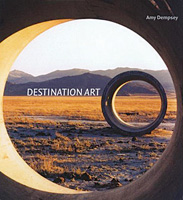home | metro silicon valley index | the arts | books | review

Destination Art
(By Amy Dempsey; University of California Press; 272 pages; $39.95 cloth)
In 1979, the traveling exhibit of artifacts from the tomb of King Tut drew audiences to museums, where they waited in lines as long as those for the opening of a Star Wars movie. If the people couldn't go to the pyramid, so to speak, then the pyramid would come to people. In the 30 years since, the emphasis has shifted to "destination art," what author Amy Dempsey defines as "art that must be seen in situ." (Although, in counterpoint, the Tut show has been on the move again lately.) Dempsey's notion proves a bit slippery in her coffee-table art book/travel guide, Destination Art. Her selections of art that must be seen "in its particular setting" veers from famous examples of obsessive outsider art—the Watts Towers in L.A.; the one-man architectural fantasy Le Palais Idéal in France—to some more obvious markers of commissioned art, like Claes Oldenburg's Batcolumn in Chicago or the many sculpture gardens designed to hold pieces that nestle into specific landscapes or are just too heavy to move: the Henry Moore Foundation in England, which boasts a bevy of bronze works by the sculptor, or the Storm King Art Center in New York, with 500 acres "planted" with steel and iron pieces. But can Mt. Rushmore really be destination art in the same way? Then why not include May Lin's the Vietnam Memorial? And while it's true that Frank Gehry's Guggenheim Museum in Bilbao is as much or more of a draw than the art within its curvy, titanium-sheathed walls, that's confusing art and architecture. The real core of destination art lies with the Earth Art movement, which took to molding the planet itself, starting with Robert Smithson's mysterious Spiral Jetty (which disappeared beneath the briny waters of the Great Salt Lake, only to resurface recently) to Walter De Maria's The Lightning Field in New Mexico, which interacts with the weather and requires an overnight stay to appreciate. Some of the more obscure European sites sound (and look in the many illustrations) especially fascinating. In Europos Parkas in Vilnius, Lithuania, a wall of more than 2,000 television sets, four screens high, wends its way through a forest, ending up at a toppled statue of Lenin; in Chandigarh, India, a road inspector gathered building junk and spent his spare time constructing an army of stone mosaic people. Northern California, however, is stinted. True, no one would cross the street to see Quetzacoatl, but Andy Goldsworthy's Stone River at Stanford is a prime example of the artist's meticulous piled-stone creations; Montalvo often displays site-specific works on its grounds; and the Runnymede Sculpture Farm in Woodside contains some 150 significant works of art on 120 acres (but is unfortunately only open on rare special occasions).
Review by Michael S. Gant
Send a letter to the editor about this story.
|
|
|
|
|
|